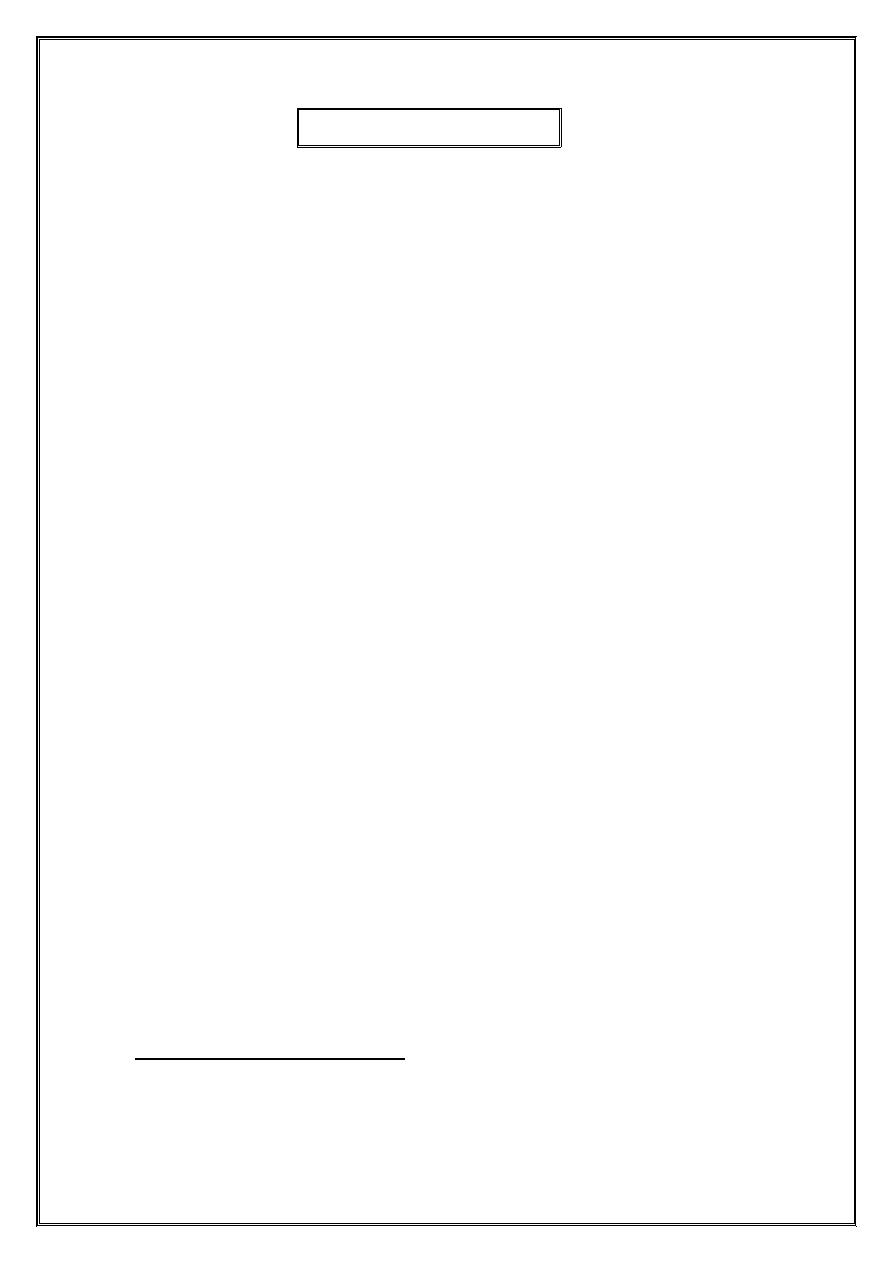
1
1
Lec:6 Local anesthetic drugs
( عدد االوراق
2
)
د.شذى هاني
م
\
3
\
موصل
18
-
3
-
8118
Are drugs employed to produce reversible loss of sensation in certain
areas of the body by interfering with nerve conduction.
Mechanism of action:
Local anesthetics act on all nerve tissues to prevent nerve impulse from
arising that means by block the nerve conduction. This effect is done by
altering the permeability of ions particularly the sodium influx through
the cell membrane which is necessary for generation the action potential.
So first to be blocked is sympathetic sensory fibers for pain,cold ,warmth
and touch and then the motor nerves which affected or inhibited to
induces skeletal muscle relaxation.
The tissue PH under normal condition is slightly alkaline, this alkaline
medium causes with local anesthetics free base:
Procaine H CL+ Na OH→ NaCL +Procain base (can penetrate lipid
membrane produces local anesthetic effect).
If PH of the tissue is acidic as in inflammation the base will not form ,so
there is no anesthetic effect be produced as in peri-apical abscesses in
tooth.
Generally local anesthesia must be:
lipophilic agents to permeate nerve membranes more readily and bind
Na channels with greater affinity .not irritant, not cause any permanent
damage to nerve structure, have rapid onset of action ,the duration of
action must be suitable to the operation performed and must be nontoxic
locally when absorbed or when reach the circulation
Systemic action:
-On Central nervous system:
The usual doses of local anesthesia produce no effects ,with the
increasing doses may cause excitatory effects resulting in anxiety

2
2
,restlessness, tremors, euphoria, agitation and even convulsion .local
anesthesia may depress ganglionic and neuromuscular transmission
-On Respiratory and cardiovascular system:
-Respiratory failure secondary to CNS depression is a late stage of
intoxication. Local anesthesia exert their effect on the cardiovascular
system if absorbed in great amount from site of injection. In toxic doses it
decrease the maximal depolarization of Purkinjes fiber, reduces
conduction velocity and it may have direct inotropic effects.
Allergic reactions:
-Uncommon. Include allergic dermatitis, urticaria, hypotension,
tachycardia and arrhythmia.
- True anaphylaxis has been documented with esters.
- Anaphylaxis to amide anesthetic is much less common
Vasoconstrictors and local anesthesia:
Vasoconstrictors particularly epinephrine or nor-epinephrine is
commonly added to local anesthesia to delay the systemic absorption and
to prolong its action locally and reduce systemic toxicity.
Concentration used for this purpose in local anesthesia is 1:200.000 or
1:400.000 and in dentist 1:80.000.
Local anesthesia are usually effective within 5 min. of application and
have duration effect 1-2 hrs. that may be doubled by adding a
vasoconstrictor agents.
Local anesthesia are classified according to their chemistry to:
-Ester compound :as cocaine, procaine ,tetracaine ,benzocaine, they are
hydrolyzed by liver and plasma esterase .
-Amide compound :as lidocaine( xylocaine) , prilocaine, mepivacine and
bupivacaine ,they are dealkylated in the liver.

3
3
Local anesthetic should be used generally depends on the duration of
action of the procedure:
-For short procedures, procaine would be recommended.
-An intermediate duration of action is found with cocaine, lidocaine,
and mepivacaine.
-Long- acting local anesthetics include bupivacaine and tetracaine.
Classification according to clinical usage:
1-Surface anesthesia: the agents directly on the skin, eye, nose, ear,
mouth, throat, trachea, bronchi and rectum. That means external
application . The preparation of surface anesthetic agents are either
cream, ointment ,gel, lozenges and sprays .e.g. benzocaine, lidocaine and
prilocaine
2-Infiltration anesthesia: is achieved by injecting a local anesthesia
directly into the immediate area of surgery to paralyze the sensitive nerve
ending and small cutaneous nerves. this type of anesthesia used for minor
operation as incision ,excision, extraction of teeth. e.g. lidocaine,
procaine, prilocaine.
3- Regional anesthesia:
a-Intravenous anesthesia: mostly used for anesthetization of extremities (
hands ,feet, arms), that we inject the agent in the distal vein of an arm or
leg without epinephrine addition because they cut the blood supply even
gangrene . e.g lidocaine and prilocaine.
b-Nerve block: to anesthetize a region by inject the drug around the
nerve (individual nerve is blocked) as sciatic nerve. e.g lidocaine and
bupivacaine.
c-Extradural (epidural) anesthesia: the agent is injected in the epidural
space to anesthetize the nerve roots .widely used in obstetric ,thoracic ,
lumber and sacral block e.g. lidocaine and bupivacaine.
d- Subarachnoid (intrathecal) block or spinal anesthesia where is done in
the lumber region below termination of the spinal cord . The problem

4
4
with this type is prolonged headache, hypotension, even infection. e.g.
lidocaine, tetracaine and procaine.
Benzocaine :
It is used for minor mouth conditions (i.e mouth sores) ,sore throat,
sunburn, and other minor skin conditions
Cocaine :
Cocaine is 2 times as potent as procaine. It is used for ear, nose and throat
procedures.
Procaine (Novocain) :
Procaine is the prototype drug of the local anesthetics. It has the lowest
potency .
It is well absorbed following parenteral administration and is
rapidly metabolized by pseudocholinesterase. It has short duration of
action (30-45 min).
It can be used in all kinds of anesthesia except surface
anesthesia. It is used for nerve block, epidural and spinal anesthesia.
Novocaine is generally not used in dentistry anymore.
Tetracaine :
It is approximately 10 times more potent (more toxic) than procaine. Its
onset of action is approximately 1-3 min, and its duration of action is
between 2 and 3 h. A 2% solution is used topically on mucous
membranes. Surface anesthesia of the eye, nose and throat. Tetracaine
hydrochloride is a commonly used local anesthetic for spinal anesthesia
requiring 2 to 3 hours of anesthesia and , in this context, usually is
combined with 10% dextrose to increase the specific gravity so that the
solution is heavier than cerebrospinal fluid.

5
5
د.شذى هاني دمحم
82
-
3
-
8102
General anesthesia
What it is General anesthesia??
is a state of Reversible unconsciousness and loss of protective
reflexes [Insensibility to Painful Stimuli] resulting from the
administration of one or more general anesthetic agents.
General Anesthetics :
Drugs used to induce a state of reversible unconsciousness. A
variety of medications may be administered with the overall aim
of ensuring -Hypnosis -Analgesia of the entire body-Amnesia-
Immobility, skeletal muscle relaxation, loss of control of
protective reflexes and of the autonomic nervous system.
Balanced anesthesia
Use of more than one agent to obtain ideal anesthesia.
Adjuncts to general anesthetics
I. Pre-anesthetic medications.
-Benzodiazepines: like diazepam to reduce anxiety and promote
amnesia.
-Anticholinergics : e.g. atropine to prevent secretion of fluids
into the respiratory tract ,drying of bronchial and salivary
secretions and decrease risk of bradycardia during surgery .
-Thiopental- Propofol: rapid induction of anesthesia .
-Opiates:e.g. morphin to induce analgesia.
II.
Muscle
relaxants:
Atracurium
,Pancuronium
,
Succinylcholine.
-Facilitate intubation.
-Suppress muscle tone.

6
6
Post anesthetic medication :
Relief of pain after surgery can be achieved with a variety
of techniques. An epidural infusion of a mixture of local
anaesthetic and opioid provides excellent pain relief after
major surgery such as laparotomy. Parenteral morphine,
will also relieve moderate or severe pain but has the
attendant risk of nausea, vomiting, sedation and respiratory
depression. The addition of regular paracetamol and a
NSAID, given orally or rectally, will provide additional
pain relief and reduce the requirement for morphine.
Postoperative nausea and vomiting (PONV) is common
after laparotomy and major gynaecological surgery, e.g.,
abdominal hysterectomy. The use of propofol, particularly
when given to maintain anaesthesia, has dramatically
reduced the incidence of PONV. Antiemetics, such as
cyclizine, metoclopramide, and ondansetron, may be
helpful.
Muscarinic agonists ,e.g. bethanechol for atony of the
bowel and urinary retention that is common after surgery
Current Levels of Anesthesia
Induction, Maintenance and Recovery
Adverse Reactions
1-Adverse reactions are many and primarily affect the heart and
lungs. They include cardiovascular collapse and arrest,
ventricular fibrillation, hyper or hypotension, respiratory
depression or arrest, and laryngospasm.
2-Sensitisation of the heart to catecholamines most notably with
halothane → dysrhythmias.
3- Malignant hyperthermia (muscle rigidity and profound ↑In
temperature).
4- Aspiration of gastric content → bronchospasm and
pneumonia .

7
7
5-Hepatotoxicity .
Classification
1. Inhalation Anesthetics
Gases:
-Nitrous oxide ( N2O:laughing gas)
Volatile Liquids:
- Halogenated Hydrocarbons compounds
2. Intravenous Anesthetics : such as barbiturate
Inhalation Anesthetics
Five inhalation agents continue to be used in clinical
anesthesiology:
-Nitrous oxide.
-Halothane, isoflurane, desflurane, and sevoflurane.
Mechanism of action
Interaction with membrane ion channels.
Enhancing the action of inhibitory neurotransmitters,
GABA and glycine thus decrease neuronal excitability as
in inhaled anesthesia ,BDZs , barbiturates .
Inhibition of excitatory glutamic acid neurotransmitters
e.g. ketamine
Notes:
• Inhalation anesthetics are particularly useful in the induction of
pediatric patients ; it may be difficult to start an iv line.
• Adults prefer rapid induction with intravenous agents.
• Regardless of the patient’s age, anesthesia is often maintained
with inhalation agent
Pharmacological Actions
CNS
-
metabolic rate.
-
ICP (due to cerebral vasodilatation)
CVS

8
8
- Hypotension
- Bradycardia except ( Isoflurane, Desflurane)
- Myocardial depression (Halothane)
- Sensitize heart to catecholamines (Halothane)
Respiratory system
- All respiratory depressants.
- Bronchodilators (Halothane – Sevoflurane).
-
mucociliary movement.
- Airway irritation (Desflurane ).
Liver
- Decrease hepatic flow.
- Hepatotoxicity (Only halothane ).
Skeletal muscles
- All are skeletal muscle relaxants to varying degree.
Nitrous Oxide (N2O)
Nitrous oxide is a colorless gas with little or no odor.
It is administered with oxygen (N2O-O2).
Nitrous oxide provides the patient with anxiety relief.
The most potent analgesic.
Weak anesthetic (low potency, combined).
The most rapid induction & recovery due to low blood
solubility.
No muscle relaxation.
No triggering agent of malignant hyperthermia
No respiratory depression.
Minimal CVS adverse effects.
Adverse Effects
N2O is cause of postoperative Nausea and vomiting
(
∵ activation of the chemoreceptor trigger zone and the
vomiting center in the medulla).
Therapeutic Uses
1. Outpatient anesthesia (dental procedures).

9
9
2. As a component of balanced anesthesia.
3. Delivery
Halogenated Hydrocarbons
These inhaled general anesthetics are called volatile liquids that
evaporate easily at room temperature because of their low
boiling points.
Halothane:
Non irritant (pleasant odor)
Potent anesthetic.
Weak analgesic.
Weak skeletal muscle relaxant.
Slow induction and recovery .
Metabolized to hepatotoxic metabolite, trifluroethanol.
CVS depression
Hypotension
Bradycardia (vagomimetic action i.e. ↑vagal tone)
Myocardial contractility.
Cardiac output
Respiratory depression.
The agent of choice in children (Pleasant).
Adverse Effects
1. Hepatotoxicity (repeated use).
2. Malignant hyperthermia.
3. Decrease the cardiac output.
4. Sensitizes heart to action of catecholamines
cardiac
arrhythmias.
Intravenous Anesthetics
1. Ultra short acting barbiturates.
2. Benzodiazepines.

11
11
3. Opioids.
4. Ketamine.
5. Propofol
6. Etomidate.
7. Neuroleptics
-Rapid induction & recovery except BZs
- Should be injected slowly.
- Can be used alone in short operation.
- Outpatients anesthesia.
- NO need for special equipments.
- Analgesic activity (Opioids & ketamine ).
- Amnesic action (BDZs & ketamine).
Ultra Short acting Barbiturates
Thiopental (Pentothal)
Thiopental :
Rapid onset of action 1 min (high lipid solubility). Ultra short
duration of action 15 - 20 min. Metabolized slowly by the liver.
Pharmacodynamics
Potent anesthetic.
No analgesic activity
No skeletal muscle relaxation.
CNS:
ICP (Used in head injuries).
CVS: Hypotension & Dysrhythmia.
Respiratory depression (dose-dependent).
Anesthesia is terminated as the drug undergo redistribution
from the brain and blood to other tissues.
Uses
1. As anesthetic alone in minor surgery.
2. Induction of anesthesia in major surgery.
Benzodiazepines
Midazolam (Versed) ,Diazepam (Valium), Lorazepam (Ativan)
-The best one is Midazolam

11
11
-Amnesic action.
-Reduce anxiety.
-No analgesic activity
Uses
1. Induction of general anesthesia.
2. Alone in minor procedure (endoscopy).
3. Balanced anesthesia (midazolam).
4. Pre-anesthetic medication (diazepam)
Side Effects
1. Slow induction & recovery.
2. Respiratory depression.
Etomidate (Amidate)
- Ultra-short acting hypnotic (non barbiturates).
- No analgesic activity.
-Rapid onset of action and short duration of action.
- Decreases
ICP.
- Minimal CVS and respiratory depressant effects.
Uses
Induction of Anesthesia
Propofol
- Hypnotic (non barbiturates).
- No analgesia.
- Rapid onset (Faster recovery than thiopental) and short
duration of action.
- Decreases
ICP.
- Antiemetic action.
Uses
1. Induction of anesthesia
2. Maintenance of anesthesia (balanced anesthesia).
Ketamine
-Non barbiturate

12
12
-Dissociative anesthesia
– Analgesia.
– Amnesia.
– Immobility.
– Complete separation from the surrounding
environment.
Pharmacokinetics:
- Rapid onset of action (slower than thiopental) and short
duration of action.
- Metabolized in the liver .
Uses
1. Minor operations (children, elderly, shock patients ).
2. Short duration diagnostic procedures
Opiate Drugs:
Fentanyl
-Rapid onset and short duration of action.
- Potent analgesia.
- No muscle relaxation
Uses
1. Cardiac surgery (fentanyl + nitrous oxide).
2. Neuroleptanalgesia (fentanyl + droperidol ).
3. Neuroleptanesthesia (Fentanyl + droperidol+ nitrous
oxide).
Side Effects
1. Respiratory depression, bronchospasm .
2. Hypotension.
3. Nausea & vomiting.
4. Increase in ICP.
5. Prolongation of labor & fetal distress.
6. Urinary retention.
Fentanyl-Balanced Anesthesia
I- Neuroleptanalgesia

13
13
Innovar (Fentanyl + Droperidol ).
A state of analgesia, sedation, muscle relaxation BUT no
loss of consciousness.
Diagnostic procedures that require co-operation of the
patient (e.g. bronchoscopy )
II- Neuroleptanesthesia : a combination of (Fentanyl
+ Droperidol + nitrous oxide).
